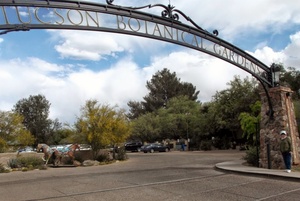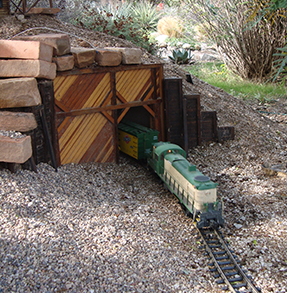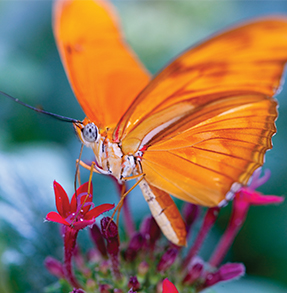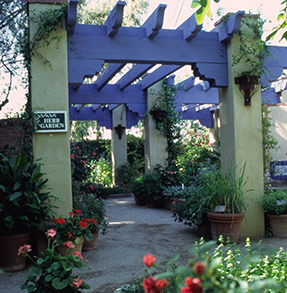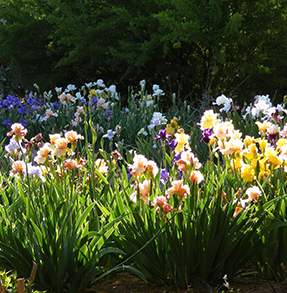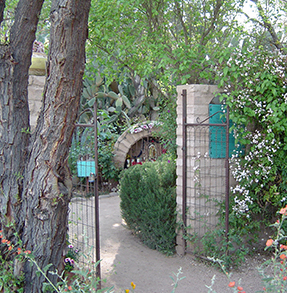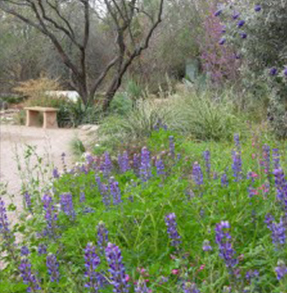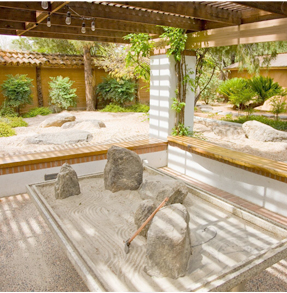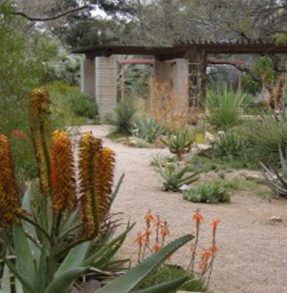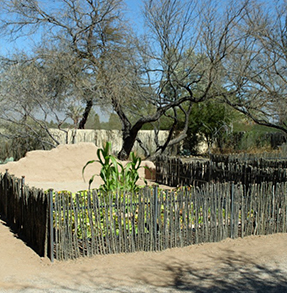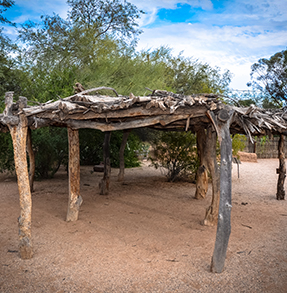History of The Botanical Gardens
The Tucson Botanical Gardens was founded in 1964 by Harrison G. Yocum. Harrison was known to be a Horticulturist which is defined as an expert in cultivation and management. The Tucson Botanical Gardens grew out of Yocum's personal garden, which had a diverse variety of cactus and palms. Yocum was a horticulturist and collector who opened his home garden to the public and eventually created a membership club for his large garden collection. Due to his extensive collection of cacti and palms, the organization only increased by members. The membership program became available in 1968 and the following year, the program became a non for profit cooperation. It was not until the membership reached 100 charter members that the decision to temporarily place the garden in a green house at Rudolph Park was put into play until they found a permanent place to put the garden. A fundraiser was formulated by friends and local garden clubs to fulfill the dream of a larger and perminant home for the garden. Eventually, in 1974 the Tucson Botanical Gardens found a perminant home at the historic porter family property. The mission of the Tucson Botanical gardens is to connect people with plants and nature. This is done through the extensive amount of art, science, history, and culture shared.
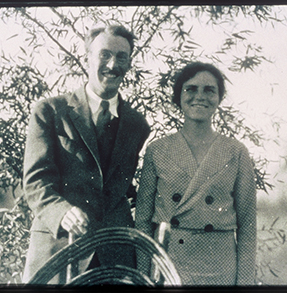
Rutger Bleeker Porter and Bernice Porter
The Porter family also took much interest in gardening. The couple started Desert Gardens Nursery at their home in 1931. Rutger Porter had been an avid landscaper known for his work at the Desert Sanatorium (Tucson Medical Center) and for creating the Desert Garden Nursery also known as Porterville. The Porter estate began with numerous landscaped patios and gardens including a mixture of natives and mediterranean plants. The original garden included winding walks, low adobe walls, foundations, along with beautiful greenery around the home. Unfortunantly, In 1958 The Desert Gardens Nursery closed and Rutger Porter passed away six years later. As a result of this, Bernice Porter donated the garden to the City of Tucson making it a city garden. When the Tucson Botanical Gardens heard of the Porter family’s goals for their garden they petitioned the city for the land. During this time the Porter family and the Tucson Botanical Gardens non-profit grew close because of their common goals.
A quote from tucsonbotanical.org by Bernice Porter: "Today a botanical garden must be much more than pleasurable, interesting, exotic. Now the necessity is a fuller understanding and application of the relationship of plants with all other life on the planet. We must realize, as never before, that plants, which are support by the earth, support the earth.”
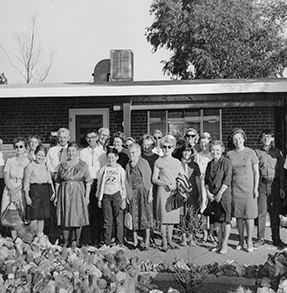
Tucson Botanical Gardens Expansion
The union between the Tucson Botanical Gardens and the Porter property became a reality by the early 1970s. In 1974, the Tucson City Council officially passed Resolution 9384 which stated that “the property would be used for the development of a botanical garden to serve as a horticultural center, a sanctuary for wild birds, and as a center for education.” The president of the Tucson Botanical Garden’s non-profit at the time, Boyd Allen, was then responsible for converting the Porter Desert Garden Nursery into the ideal location for the Tucson Botanical Gardens. After the resolution passed Mrs. Porter said, “We just didn’t want to see this place go down under a bulldozer… Now it will continue to offer as much pleasure to others as we have enjoyed in the past." . Preserving the historical aspects of the property, many of the buildings located on the site date back to the 1920s and were constructed of adobe brick. Bernice was also allowed to live on the property until her death in 1983 and was often cited as helping the Tucson Botanical Garden become accustomed to their new home on Grant and Maple.
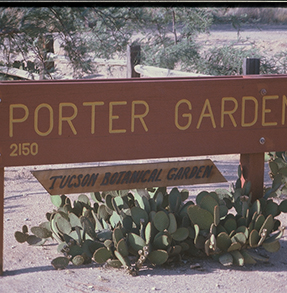
Classes and Programs
UA Science Cafes at the Gardens- Includes a series of public talks given by Arizona professors and graduate students. It brings the community together to discuss and learn about the latest research being conducted. It gives people the opportunity to ask questions and deepen there understanding on science and nature.
Urban Forestry Certificate Program- Developed with the support from the Arizona department of Forestry and Fire Management to train Arizona citizens how to take care of our urban forests. The program also offers professional development for conducting landscaping and nursing. The Tucson Botanical Gardens even offers a certification for students who complete all 7 required classes and 5 elective classes. The required classes are Urban Forestry & Community Health, Tree Biology Part 1: Roots & Stems, Tree Biology Part 2: Leaves & Flowers, Tree Identification, Tree Care Part 1: Selection & Growing Conditions, Tree Care Part 2: Planting & Management, and Principles of Pruning. Elective classes will vary throughout the years so it is important to check for quarterly emails on upcoming classes. You can find these classes through the link https://tucsonbotanical.org/program/urban-forestry-certificate-program/
The Tucson Botanical Garden also offer two programs for teachers and families. There are specials classes and programs listed for families.For Teachers they provide field trips for youth groups, college groups, and community groups.
Pre K - High School:https://tucsonbotanical.org/classes-programs/request-a-field-trip/
College Groups: https://tucsonbotanical.org/classes-programs/request-a-field-trip/college-group-rate/
Community Groups:https://tucsonbotanical.org/request-group-visit/
For Families: https://tucsonbotanical.org/program/for-families/
Horticultural Therapy: In 1983 the garden started their Horticultural Therapy program (Hort Therapy) and it is still the only program of its kind in Arizona. Currently, this program is providing services to residents of nursing homes and assisted living facilities in Tucson, AZ. They offer various sessions including an on-site program where individuals work on gardens that are visible to guests. This is a practice that has been proven beneficial and more information can be found using this link: https://tucsonbotanical.org/hort-therapy/
For families there is an extensive amount of family fun days, summer camps, and other programs. One club is the Youth Horticulture Club which is a service-learning opportunity for high school students. These students learn about biology related careers, to engage in horticulture activities and to learn indigenous methods of farming and agriculture. There is also a STEMtember Girl Scouts Day at the Gardens which is dedicated to to girl scout activity's to complete there badges.
Contact [email protected] for additional information.
The Tucson Botanical Gardens website also includes "Southwest Planting Tips by Month" found here: https://tucsonbotanical.org/community-resources/
The Tucson Botanical Gardens has a 5.5 acre (2.2 ha) collection of seventeen residentially scaled urban gardens in. The path connects the garden with Zen Garden and other gardens. There are many species of butterflies mostly tropical butterflies. It is also common place for native crops and vegetation's.
JANUARY
Check weather forecast for freeze warnings. Cover the tips of sensitive columnar cacti with styrofoam cups. Use frost cloth or a blanket to cover aloes, citrus, and other sensitive plants when temperatures drop below 28°F. Water winter annual wildflowers once a week. Thin wildflower seedlings if crowded. Recycle your cut Christmas tree

FEBRUARY
Protect sensitive plants on nights below 28°F. Leave any frost-killed foliage and branches on landscape plants – this will protect the base of the plant, which should re-sprout. Fertilize citrus, fruit trees, roses, and lawns on Valentine’s Day. Prune mesquites and other large trees, grapes, and roses. Plant spring-blooming bulbs and garden annuals. Begin harvest of citrus

MARCH
The average last day of freezing weather is March 15th. After this date, prune frost-damaged foliage and branches. Purchase and plant new perennials, shrubs, trees, annuals, and herbs. Plant spring vegetable garden. Spread mulch under and around plants. Continue to harvest citrus

APRIL
An ideal month to plant cactus & succulents, citrus, and palms. Finish the planting of herbaceous perennials and herbs. Fertilize shrubs. Increase watering as temperatures rise. Adjust irrigation clock to increase watering frequency. Stop watering winter annual wildflowers, collect seed, and rake up dried remains

MAY
Finish the planting of cactus & succulents. Place shade cloth over newly planted cacti & succulents to avoid sunburn. Continue to increase watering and irrigation, especially for plants in containers. Fertilize citrus, fruit trees, roses, and lawns on Memorial Day

JUNE
Avoid planting new plants during this, the hottest month. Watch for signs of water stress and sunburn. Increase watering, but beware of hot hose water. Stop mosquitoes before the summer rains by eliminating places where water may collect. Watch for pests like cactus longhorn beetles and agave snout weevils. See the Arizona queen of the night cactus when it blooms. Garden in the early morning or late evening to beat the heat

JULY
Avoid planting new plants except summer wildflowers or monsoon-season crops. Collect rainwater through water harvesting. Use BT mosquito dunks in any standing water. Maintain watering for most plants, but discontinue temporarily after heavy monsoon rains. Stop watering cacti & succulents if moderate to heavy rains arrive. Prune drooping tree limbs or wind-damaged branches

AUGUST
Keep weeds under control. Trim and dead-head spent flowers, but do not replant until cooler weather. Prepare vegetable and annual flower beds for planting. Watch for iron deficiency on roses – treat with chelated iron

SEPTEMBER
An ideal month to plant most trees and shrubs. Fertilize citrus, fruit trees, roses, and lawns on Labor Day. Prune plants to shape after summer rains. Harvest pomegranates. Plant tomatoes, peppers, beans, squash, gourds, and pumpkins. Divide and transplant iris. Prepare a site for winter annual wildflowers

OCTOBER
Reduce watering to help plants harden-off for winter. Adjust irrigation clock for less frequent watering. Plant cool-season annuals, vegetables, and herbs. Continue to plant trees and shrubs. Plant hardy cactus & succulents. Move adeniums, Madagascar palms, stapelias, and other cold-sensitive succulents indoors. Prepare frost cloth and cactus-covers for the arrival of frost

NOVEMBER
Begin checking the forecast for freeze warnings. The average first frost arrives mid-November. Prepare to cover and protect sensitive plants when temperatures drop below 28°F. Bring potted succulents indoors when in doubt about cold sensitivity. Further reduce watering and irrigation. Sow winter annual wildflower seeds and water them in. Collect fallen leaves and add to compost pile. Harvest Mexican limes

DECEMBER
Check weather forecast for freeze warnings. Cover the tips of sensitive columnar cacti with styrofoam cups. Use frost cloth or a blanket to cover aloes, citrus, and other sensitive plants when temperatures drop below 28°F. Reduce watering and irrigation frequency to a minimum, but water thoroughly when needed. Water annual wildflower seedlings once a week during dry winters. Plant bare-root roses and fruit trees. Choose an Aleppo pine or Mondell pine as a live Christmas tree, if desired for planting in a low water-use landscape
Admission
Adults: $15
Students, Seniors (62 years and up), & Military: $13
Children (4-17): $8
Members & Children under 4 Free
Membership
A membership will allow a guest to enter the garden for free for a year as long as the membership is renewed. There are three different types of membership that allow single adult entrance or a plus one guest pass. This option is best suited for locals that live in the area and enjoy spending time at the garden. An option for a dog membership is even allowed to add to a person's already existing pass. To join just fill out their membership application that can be found following this link:https://tucsonbotanical.org/membership-form/
2150 Club: A newly established club for adults from ages 21 to 50 focuses on social and philanthropic opportunities in environmental sustainability, gardening, and supporting the Tucson Botanical Garden. For the price of $15 per month members have a 12 month access to free entrance to the garden, discounts at the gift shop as well as classes, and indentations to exclusive events. This option is more for those wanting to become involved in their local community and interested in the environment.
Donate
To sustain its hands-on and instructional purpose, the Gardens rely on donations. These tax-deductible gift help keep this local treasure and Urban Oasis in the Heart of Tucson alive and well. To start donating click on the following link: https://tucsonbotanical.org/donate/
There are several programs the Tucson Botanical Garden you can donate to:
Donate Now: https://12197.blackbaudhosting.com/12197/TBG-Donate-Now
Tributes & Memorials: https://tucsonbotanical.org/donate/tribute-or-memorial/
Hot Summer Day: https://12197.blackbaudhosting.com/12197/Hot-Summer-Day-Fund
PDF copy of Tucson Botanical Garden Donor Privacy Policy: https://tucsonbotanical.org/wp-content/uploads/2017/12/Donor-Privacy-Policy_rev-December-2017-1.pdf
2150 N Alvernon Way, Tucson, AZ 85712
Garden Hours:
Daily 8:30 am to 4:30 pm
TIME BLOCKS:
8:30am-10:30am
10:30am-12:30am
12:30am-2:30pm
2:30pm-4:30pm
Butterfly Magic Hours:
Daily 9:30am to 3:00pm
The exhibit included with Gardens Admission
CLOSED: January 1st (New Year’s Day), July 4th, Thanksgiving, Christmas Eve & Christmas Day
General & Administration
520-326-9686 ext. *10
Butterfly Office
520-326-9686 ext. *38
Membership
520-326-9686 ext. *13
Education
520-326-9686 ext. *18, * 19, *39
Facility Rentals/Special Events
520-326-9686 ext. *29
Facilities
520-326-9686 ext. *17
Horticultural Therapy
520-326-9686 ext. *26
Horticulture
520-326-9686 ext. *17, *14, *40
Gift Shop
520-326-9686 ext. *16
Marketing
520-326-9686 ext. *35
Executive Director
520-326-9686 ext. *15
HR/Volunteer Office
520-326-9686 ext. *10
Café Botanica Phone
520-326-9686 ext. *37
Café Botanica:
Dine amid the birds and flowers
Open 7 Days a Week | p. (520) 326-9686 x *37 | Hours: 8:30 a.m. to 3:00 p.m, seven days a week
Café Botanica is run by long-time Tucson caterer and Gallery of Food owner, Kristine Jensen. The menu is inspired by the culinary traditions of the Sonoran desert and high-desert of Northern New Mexico. Kristine and her team are committed to using local, sustainable ingredients and gleaning from the Gardens when possible.
Please note that:
– Admission to the Gardens is a separate and required cost for all Edna’s Eatery guests.
– At this time, reservations are not taken.
PDF of Café Botanica Menu: https://tucsonbotanical.org/wp-content/uploads/2021/10/10.1.2021-Ednas-Eatery-Menu-1.pdf
Catering
For information regarding event booking or premier catering with our exclusive partner, Westward Look Resort, please contact Mary Ann Confrey, Facility Rental Manager, at [email protected] or (520) 326-9686 Extension *29.
Additional information is available at https://tucsonbotanical.org/host-an-event/
Map:

Link: https://tucsonbotanical.org/wp-content/uploads/2015/08/TBG-Visitors-Map_edit-1.pdf
Gardens:

Aloe Alley is a quiet and shady garden path, a favorite with Gardens employees. See hummingbirds flock to this area when the Aloe is flowering.
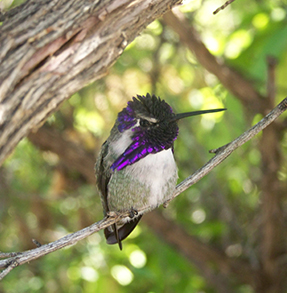
The Backyard Bird Garden shows how to attract birds in a natural way. Watch for hummingbirds, cardinals, and quail year-round.
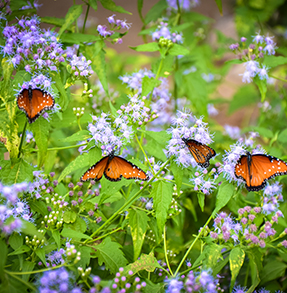
The Pollinator Garden displays a variety of seasonal plants that attract regional and migrating pollinators including butterflies, bees and birds.
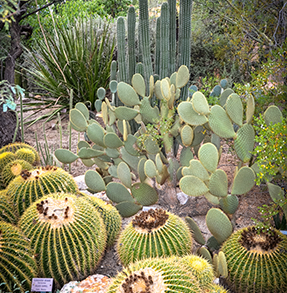
The Cactus and Succulent Garden features cacti from the southwestern states, Mexico, South America, and Africa, plus hardy Old and New World succulents.
The Children’s Discovery Garden takes you on a journey through the life cycle of a plant.
Watch the train as it winds through a miniature town. Hear it chug and whistle as you stroll around the Gardens. (Operation subject to weather and other conditions)
Home to Butterfly Magic, the Cox Butterfly & Orchid Pavilion, in addition to the seasonal Tropical Butterfly display, contains an impressive selection of tropical plants such as Orchids, Hibiscus, Sword Ferns and Bromeliads.
The Herb Garden displays a rich variety of culinary, fragrance, and medicinal herbs that can be grown in Tucson.
The Shade Garden demonstrates which regional plants thrive and are appropriate for shady spots.
The Historical Garden features many trees and shrubs commonly planted in Tucson during the 1930s, 40s, and 50s – including olive, myrtle, and dwarf citrus.
Don’t miss the Iris Garden in April when it’s in full bloom. You will see a spectacular display of color and a wide variety of bearded iris.
(Barrio Garden) Nuestro Jardin honors Tucson’s traditional Mexican-American neighborhood gardens with a charming and colorful display of flowers, trees, herbs, and objects commonly seen in barrio gardens.
The Wildflower Garden features a variety of southwest annuals and perennials such as, Penstemon, lupine, Mexican gold poppy, desert marigold, and owl’s clover, which are in bloom during spring. In the summer space is graced with a Mexican hat and chocolate flower.
The Zen Garden is a quiet haven for reflection and peaceful contemplation.
The Xeriscape Garden demonstrates a beautiful, lush and low-water-use landscape, perfect for any Tucson backyard.
The Native Crops Garden displays traditional crops from the southwestern U.S. and Mexico with an emphasis on plants grown by the Tohono O’odham.
Plants of the Tohono O’odham path honors the relationship between native peoples and the plants of the Sonoran Desert.
Photos and Information Thanks to the Tucson Botanical Gardens Website:https://tucsonbotanical.org
First photo fromhttp://grandmasrecess.blogspot.com/2014/04/good-bye-tucson-2014-see-ya-in-2015.html

